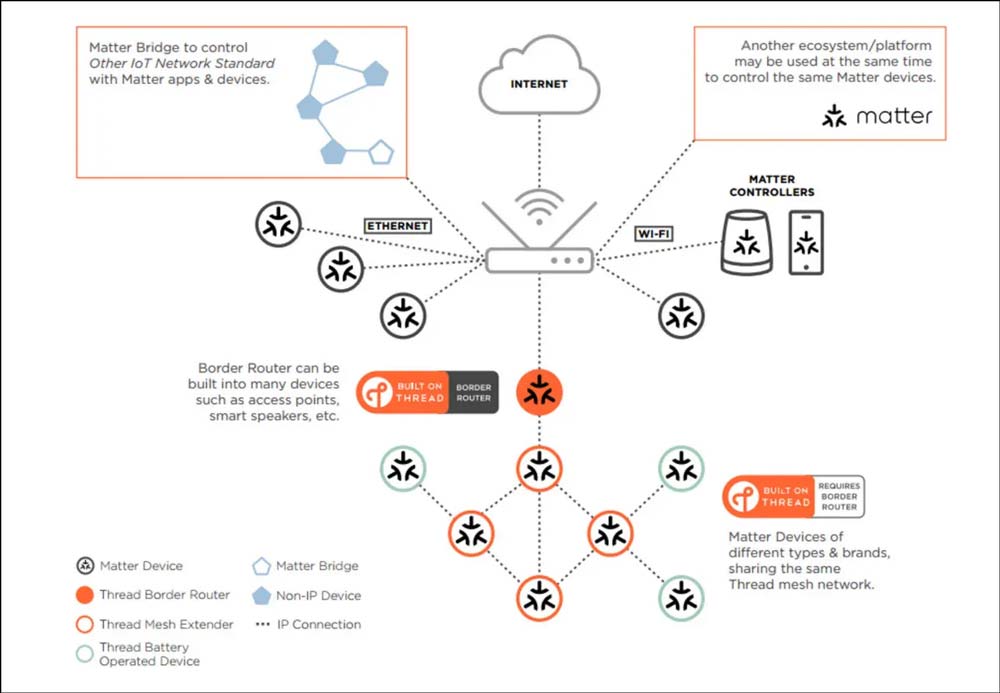
Setting up and pairing smart home tech has always been a little limiting. If you find yourself using devices from different ecosystems, there is a good chance that the thing you thought would make things easier actually makes it more difficult. Matter is set to change that. This guide will explain what the Matter standard is and why it’s so important to the smart home user.
In its current state, building a smart home with devices that connect to each other can be a little difficult. Your best bet is to stick to one ecosystem governed under a single standard, such as Google Home, Apple Homekit, or Samsung SmartThings.
If you followed that guideline, there’s a good chance your light bulbs, switches, smart blinds, and other devices will all talk to each other and work as you want them to, so long as they were made by the same company.
The faults of current smart home products really start to rear their heads when you start to buy products from different manufacturers, even if they both work with Google Home or Apple HomeKit. You’ll find that devices can work in some respects but often don’t play nicely with each other. For instance, some brands are exclusive to one ecosystem. Eve, for example, has always only supported HomeKit, meaning customers with Android phones are unable to use or control those devices.
What is Matter?
What the Connectivity Standard Alliance set out to do with Matter is to connect those smart home products – whether or not they’re from different manufacturers or only work with certain standards – and develop a bridge between them, linking them through a simplified standard that’s easy for each device to understand.
Matter was officially launched around a month ago through an initiative from Google and other smart home manufacturers to close that gap between devices and ecosystems that didn’t necessarily play nice with each other. With that, more companies are able to produce tech without having to gain certification with a dozen different standards. Rather, each can focus on one or two and know that its products would work with hundreds of others.
Matter has pledged upcoming support for around 200 different products, including some from Philips Hue and Google. The first few devices are the Google Nest lineup, including the Nest WiFi Pro, which works as a Thread border router.

How Matter works
Bringing hundreds of products together and connecting them in a way that forces them to play nice isn’t easy, but the idea can be simplified to a basic process.
In essence, Matter is sort of like a middleman. Any action a device takes goes through Matter. From there, it can be controlled from other devices quickly and with relatively no delay. There are two ways it can do this. The first is the traditional Wi-Fi connection, which sends a signal over a local Wi-Fi network to other devices. The second way is something called “Thread,” which is a fast networking protocol that works in conjunction with your Wi-Fi network.
What is the “Thread” protocol?
Thread is a common feature of mesh networks, as the two go hand-in-hand. With that, Thread devices always have a solid connection as multiple devices can emit a low-energy signal, maintaining a constant strong connection. You can think of the Thread protocol as another lane in your local network, with certain devices opting to take that route with less traffic and higher speed limits. This relieves a lot of strain on one connection path, allowing for faster and stronger connections for every device involved.
Smart home tech that relies on battery power, such as sensors, are fantastic candidates for the Thread protocol, as it doesn’t take much energy to use and can be maintained more easily. In reality, most devices would do better to work with Thread over Wi-Fi, though more companies would need to adopt it in their products.
Of course, in order to use Thread-enabled devices, you would need a Thread border router, which is a device that can tie those devices into your internet connection. Currently, the Google Nest Hub Max, Nest Hub (2nd Gen), and Nest WiFi Pro all work as Thread border routers, which means you can start building your Matter empire now. As more companies work toward incorporating Matter, there are likely to be more Thread border routers popping up on the market.

Are Matter devices easy to set up?
Even though the standard has been officially alive for a limited time, companies like Google are already on top of supporting it. With that, Android is already being prepped with quick Matter integration and setup, bringing Fast Pair to the smart home, much like it would be used to pair earbuds or a smartwatch.
What that essentially means is that devices supporting Matter will be extremely easy to get up and running with Android. Here are the generalized steps you’ll need to take with most Matter devices:
- Put the device into pairing mode and wait for the Fast Pair prompt to appear for your new device.
- Scan the QR code.
- Choose your preferred controller app.
- Note: This is either Google Home, Samsung SmartThings, or another app.
- Connect your Google Account.
- Choose the device location and give it a name.
Of course, we haven’t had a chance to truly give this a go, though we expect the actual process won’t be far off. As complicated as some smart home products can be in setup, we expect that Matter will provide a bit of relief when installing new bulbs or whatever you may have.
Is Matter actually being used yet?
As mentioned, Matter is a product of the majority of smart home tech manufacturers and companies. Supporting this new standard means products are compatible with more homes and are much easier to use, which becomes a win-win for everyone. This breaks the barrier for a lot of people, as they don’t need to stick with just one standard like Google Home or HomeKit.
With that, the current list is big, made up of over 15 different companies with products certified. Beyond that, even more have announced upcoming support for the Matter standard. Of course, this is just the first step, as no smart home products outside of Eve’s lineups are using Matter as of yet. We expect this to change relatively soon.
What kinds of devices does Matter support?
Currently, Matter has a plan in place to support a select few categories of devices. This is the current groupset that will be compatible with the standard:
- Bridges
- Controller
- Windows coverings
- Door locks
- HVAC controls and sensors
- Lights
- Speakers
- Shades
One glaringly obvious exclusion is cameras. Because of the security concerns behind controlling security cameras, there’s a bit more work that needs to be done. Beyond that, almost every other category is covered.
Generally speaking, cameras have become their own subset of smart home products, with the camera’s native app being the best one to use, as it inherently has more features and tools. The other categories in smart home tech make sense as Matter candidates. Most require a simple toggle for on or off and don’t require an entire app filled with specific tools to use them.
The sudden wave of Matter integration is surprising, though it’s more than welcome. With big companies integrating the Matter standard in existing and new devices, we’re truly hoping that smart home tech becomes more accessible and easier to use for everyone, no matter what devices they run.
More on Matter:
- Google brings Matter support to Nest devices and Android starting today
- These Google and Nest devices work with Matter
- Matter smart home standard launches with almost 200 certified devices, plans for cameras
FTC: We use income earning auto affiliate links. More.

Comments